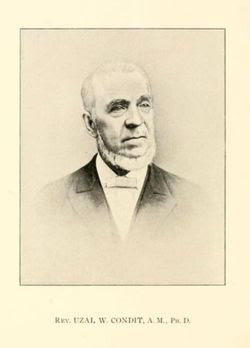Rev. Uzal Wade Condit, Easton’s Historian
Rev. Uzal Condit was born in Genoa, Cayuga County, NY on August 18, 1815. His family ancestry is documented, with his Condit family originating in Orange, New Jersey. His parents were Uzal Condit (b.1785) and Phebe Wade (b. 1784). Siblings of Uzal, Isaac and Henry, were born later.
Condit’s father died when he was very young so he had no memory of him. He stated his mother was a teacher and took good care of her children. Condit’s mother told him at an early age he would have to learn a trade and when old enough, he chose to apprentice with a shoemaker. He did very well with this trade, but longed to have an education. With his wife’s full moral support, he purchased his indenture and started at being a student along with his work. Condit married Martha E. Vanhouten sometime around 1837 and had their first child, William Baldwin in 1838. Mary was born @1840, Emmaline Phoebe came next in 1842 and Antoinette (Nettie) was born in 1845. All this time he attended Williams College in Williamstown, MA and graduated in 1847. He said it was not an easy time between work, children, money for school and being married, but three years later in 1850, he graduated from Union Theological Seminary in New York City. In 1856, he and his wife welcomed Clara Gertrude to their family.
His first charge was in Lynnfield, MA where he remained for 5 years. After that, 8 years at Deerfield, NH. Condit mentioned that while here, it was some of the happiest years of his life. While in this state, he was appointed president of the State Board of Education by the Governor of New Hampshire. A few more churches followed after this and in 1872 he came to Easton. His daughter Emmaline Cramm, had lost her husband in the Civil War and being left with five children and living in Easton, needed him and his wife’s assistance. At age 57, “I decided to look for work in the world of literature, and while looking over the field of historic research, the thought of writing the history of Easton flashed upon my mind.” His first plan though, was to write the history of Artic exploration, but was told by Professor March, at Lafayette College, that a book was already being printed about that subject. His next thought was writing about the Nile Exploration. After realizing this research would take him to the large libraries of New York to prepare for the work, he decided he could not do this. He later said he felt very fortunate he did not write of the Nile, as shortly after, a book came out on this subject.
Eventually he turned his writing and research to the history of Easton, his adopted town. He had “come to love the beautiful hills and valleys and rivers and the heroic history of her infant life and her educational history, and this made me happy in the work.” It took Condit six years to write and finish the book.
“Much of the material was gathered from old people who were soon to pass away, and from family records, old wills, scraping the moss from old tombstones and visiting old houses. The late Elisha Allis, Esq., kindly put his library at my disposal, as if it were my own. He had a full set of the Colonial Records, Pennsylvania Archives, in which I found the early history of Easton embedded. In these silent old volumes, I found the beautiful character of Paxinosa, which I first drew from its silent resting place and placed the name on the mountain top.” For more detailed acknowledgements see the books, Author’s Preface.
“The History of Easton, Penn’a from The Earliest Times to the Present 1738 – 1885” by Rev. Uzal W. Condit, A. M. and published by George W. West, was printed in numbered pamphlets, in the chronological order of its occurrence. First being printed in 1885. It has many beautiful illustrations, along with the histories.
Condit wrote about many local Easton and historic men, many of his articles would appear in the Easton newspapers. Benjamin Franklin, John Arndt, George Taylor, but one of his favorites was William Parsons.
Condit had a deep admiration for William Parsons, “noble father of our beautiful city.” Parsons died in 1757 and was buried in the First Reformed Cemetery, here in Easton. He tried, unsuccessfully, in 1891 to have a monument erected for him on Center Square. He then wanted Parsons to be re interred to Easton Heights Cemetery along with a monument and was told no by the First Reformed Church Cemetery committee. In 1899, he brought up a plea for the Parsons-Taylor House, built in 1757 by Parsons, to be preserved as it was a historic building. Thanks to the local DAR, it was. Condit had a few similarities to his idol. Both had humble beginnings, both started as shoemakers, both knew that they wanted an education and got one and both gave something to Easton.
On May 21, 1886, his beloved wife died. On May 11, 1887, he married Mrs. Sophia Van Doren Opie. Sophia died February 3, 1897 and is buried in Somerville, NJ.
September 17, 1902 at age 88, Uzal Wade Condit passed away. He is buried with his first wife, Martha at Easton Cemetery. Also buried there are his daughters, Antoinette (Nettie) Thompson, Emmaline (Emma) Cramm, Clara Gertrude Condit and his son, William Baldwin Condit.




.jpg)

